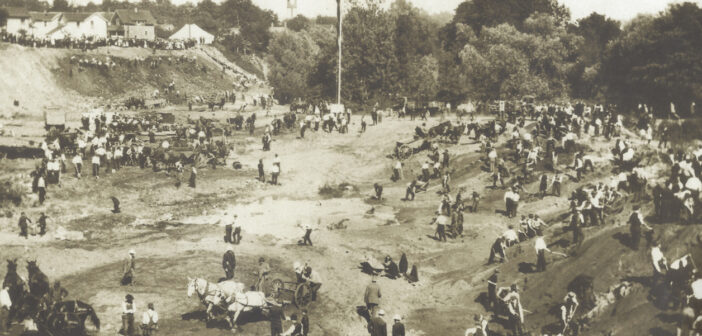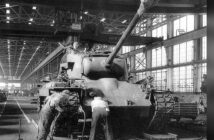It’s a world class and legendary place; but it started out as the Atwood Lumber Mill on Moon Island, situated along the Flint River. When the mill was shut down, it was leased to Flint as the city dump site. As the city grew exponentially with the advent of the auto industry, the city fathers thought it might be the perfect location for a city park. So, on one day in 1917, a cavalcade of community volunteers turned out to clear the dump and make way for the anticipated park. But nothing more came of the park plan and eventually, Moon Island reverted to a dump.

In 1917, Moon Island was cleared to make way for the city park that ultimately became Atwood Stadium. Construction started 12 years later. Photo: Atwood Stadium Authority 75th Anniversary Commemorative book
By 1927, Flint was booming. With Flint Central High School bursting at the seams and a new high school to be called Flint Northern in the works, it was clear that athletics would take the forefront of what would bind the community together. Central had already won back-to-back state football championships, and athletics of all kinds had been flourishing at Athletic Park – which was located roughly where the University of Michigan Flint property is now – and near the former locations of both the IMA and AutoWorld complexes. But both the scope and large crowds drawn to the events were exceeding that venerable site’s capacity.

Flintstone Edwin W. Atwood (left) donated the site to Flint along with $5,000 in the name of his father, William A. Atwood. Photo: Atwood Stadium Authority 75th Anniversary Commemorative Book
It was up to Flintstone Edwin W. Atwood to come to the fore with a plan to move forward with the original city park idea, but with a formidable stadium as the epicenter. Atwood donated the site to Flint along with a development check for $5,000 ($91,000 in 2024 dollars) in the name of his father, William A. Atwood. The city went to work filling a river channel, eliminating Moon Island and laying the architectural groundwork for what would become Atwood Stadium.

The epic last concert at Atwood Stadium was on August 02, 1980 – Journey, Pat Benatar and Eddie Money.
On June 8, 1929 the stadium was dedicated and soon became one of Michigan’s top venues for sports, entertainment and community functions. As the years rolled by, it would see some incredible events, including:
- World Championship Boxing featuring Flint’s Jock Leslie losing to Willie Pep in 1947
- Appearances by sports legends Jesse Owens, Ted Williams and Jack Dempsey
- Speeches delivered by Presidents Franklin Roosevelt and John F. Kennedy (as a candidate)
- The celebration of the 50 millionth GM car in 1955
- The Who making their first U.S. concert appearance in 1967
- An epic 1980 concert trio featuring Eddie Money, Pat Benatar and Journey
- The Flint Arrows Minor League Baseball team won the 1948 Central League title with 118,000 fans watching during the season.
- Dinah Shore and other celebrities observed Flint’s Centennial parade and show at Atwood called “Flint O’ Rama” that drew over 200,000 spectators in 1955.
- The Flint City Bucks soccer team won the National Championship in 2019.
- Future athletic superstars played football at Atwood, including Andre Rison, Jimmy Abbott, Booker Moore, Lynn Chandnois, Clarence Peaks, Robaire Smith, Merv Rettenmund, Herb Washington, Rick Leach, Dennis Johnson, Leo Sugar, Thomas Rawls and future Heisman Trophy winner, Mark Ingram Jr.
But with all that incredible history, there was one long-running event that topped them all: The Flint Northern vs. Flint Central Turkey Day Football Classic. The two schools were athletic powerhouses, with one typically among the state’s top football programs year after year, and both typically in the upper echelon.

Presidential Candidate John F. Kennedy speaking at Atwood in 1960. Photo: Atwood Stadium Authority 75th Anniversary Commemorative book
The talent level was so strong that the two schools won nearly 60% of all mythical state championships between 1923 and 1960, and so ubiquitous that top players became stars across the country at colleges like Alabama, Michigan and Michigan State. In fact, MSU’s football team could have started an entire Flint football team with two players to spare! In 1950, the Thanksgiving Day game drew nearly 21,000 fans to watch a thrilling, last-minute Northern victory.

Turkey Day Classic action from the 1954 game.
My first trip to Flint’s Atwood Stadium is seared into my brain. One day, my mom told me my dad would have a big surprise for me when he got home from work. As a five-year-old, I assumed that meant a toy of some kind, or maybe a comic book or two. Instead, I was told that he had secured “box seats” for a high school football game. I had never seen anyone “sitting in a box”, but it sure sounded like fun! Later,
I learned that it just meant that we had terrific seats.
The aforementioned game wasn’t just a regular game. It was a really big game: the annual Turkey Day matchup between Flint Central – my neighborhood school – and bitter cross-town rival, Flint Northern.
The aforementioned game wasn’t just a regular game. It was a really big game: the annual Turkey Day matchup between Flint Central – my neighborhood school – and bitter cross-town rival, Flint Northern. The game had been played regularly since 1928 and had once attracted crowds as large as 21,000. This game was big, too, because if Central won, they would be crowned Michigan Class A State Champions, heightening anticipation.

Program from the 21st Annual Turkey Day Classic.
So, off we went on my first trip to Flint’s Atwood Stadium. The pageantry of the bands, the card sections in the end zones, the chants and cheers amidst the chilly November air were positively intoxicating. The stands were filled with kids, neighbors and friends. My cousin Debbie played in Northern’s amazing marching band. Older guys from the neighborhood were on the field playing. I had listened to rival coaches on a radio show the night before. I knew Mom and Grandma were home cooking the Thanksgiving dinner, with Grandpa and my baby sister. Norman Rockwell had nothing on Flint and Atwood Stadium!
The beautiful stadium with its modern AstroTurf was positively pregnant with tradition, excitement and community. It was a temple that attracted blue collar workers who built Buicks and Chevys along with doctors, lawyers and business owners. Black, white, rich, poor, old and young. College recruiters from around the country regularly attended this game to scout the talent, take in the atmosphere and worship at this shrine of sports and achievement.

Gary and his “Pops” attended a city game at Atwood every Football Friday through the ‘70s. Here, the superfans pose outside Atwood Stadium with Flint Central and Flint Northern helmets. Pops Fisher passed in 2023, but his legacy lives on through his son Gary and grandson, Luke Johnson. Gary served on the Atwood Stadium Authority committee and continues to be active at Atwood hosting and emceeing the CANUSA games there, announcing high school football games, and as an occasional announcer for Flint City Bucks soccer games. Last year, Luke joined him in the booth as a guest announcer continuing the Atwood Stadium family tradition.
What a day – the 1970 state championship at stake, the ancient rival’s game, the Thanksgiving Day Game. It was better than Disneyland! Later that day, and for years afterward, my pal Dennis King and I would reenact the Turkey Day game in my side yard, play by play, including the year when Central’s drum major slipped and fell – Dennis had to act out that bit.
Northern upset Central that day and I was hooked! In fact,
I never missed another Northern-Central game. I would attend every single one for the next 35 years, even traveling home from across the state or around the country to do so.
For me, Atwood is the structural symbol of Flint, standing strong, proud and unbowed.
My dad and I established an ongoing tradition, as well, attending a city game at Atwood every Football Friday for the next decade. Eventually, I would go on to play football for Flint Central in my very own Central-Northern games. That they weren’t played on Thanksgiving did nothing to diminish the rivalry, nor my feeling of being part of a rich tradition. In fact, it felt like a birthright.
The reason the games I played in weren’t held on Thanksgiving Day was because the game tradition ended in 1976 with the advent of the Michigan state playoffs. But in 1977, the powers-that-be held a reunion game on Thanksgiving and invited all the greats from the previous 50 years for one more go. I attended that game with my buddy, Brian Knight. My mom dropped us off at the Atwood gate and we made a beeline for the sidelines where lax security permitted us open access.

Gary Fisher and his Pops with the Holy Grail of Turkey Day Classic items: the original Dr. A.J. Wildanger Trophy that was awarded to the victors, and the ball from the inaugural 1928 contest between Central and Northern.
As the game wound down, former Northern star Russ Reynolds invited Knight and me to get in for a “play or two.” We eagerly accepted, and jetted around the AstroTurf with Reynolds and the collection of old timers and local legends. Reynolds had played in the first Central-Northern game in 1928 even before it was held at Atwood. I knew his story even then, and being on the field in a nostalgia game with him and the others as a 12-year-old kid was thrilling – even if it was flag football and even if Reynolds was pushing 70. I was on that field!
When the grand dame fell into disrepair, I served as a volunteer on the renovation committee. It was unthinkable to me that it could ever go away. Ultimately, she was saved by Kettering University and will continue to be a hallowed place to house a well of unshakable memories for a new generation. Kettering’s effort is one of the greatest preservation wins in Flint history. For me, Atwood is the structural symbol of Flint, standing strong, proud and unbowed.
In 2011, my pal Knight died of a sudden heart attack and that made a discovery shortly thereafter even more bittersweet. While watching a tape of that ’77 “Nostalgia Bowl”, I noticed a couple of kids in the shot. There, on my screen, amidst the legends, was me and Knight! Like him, many of those players are now long gone. I paused the video and stared at the screen: ghosts of the past in the Temple of the City. It couldn’t have felt more appropriate.














